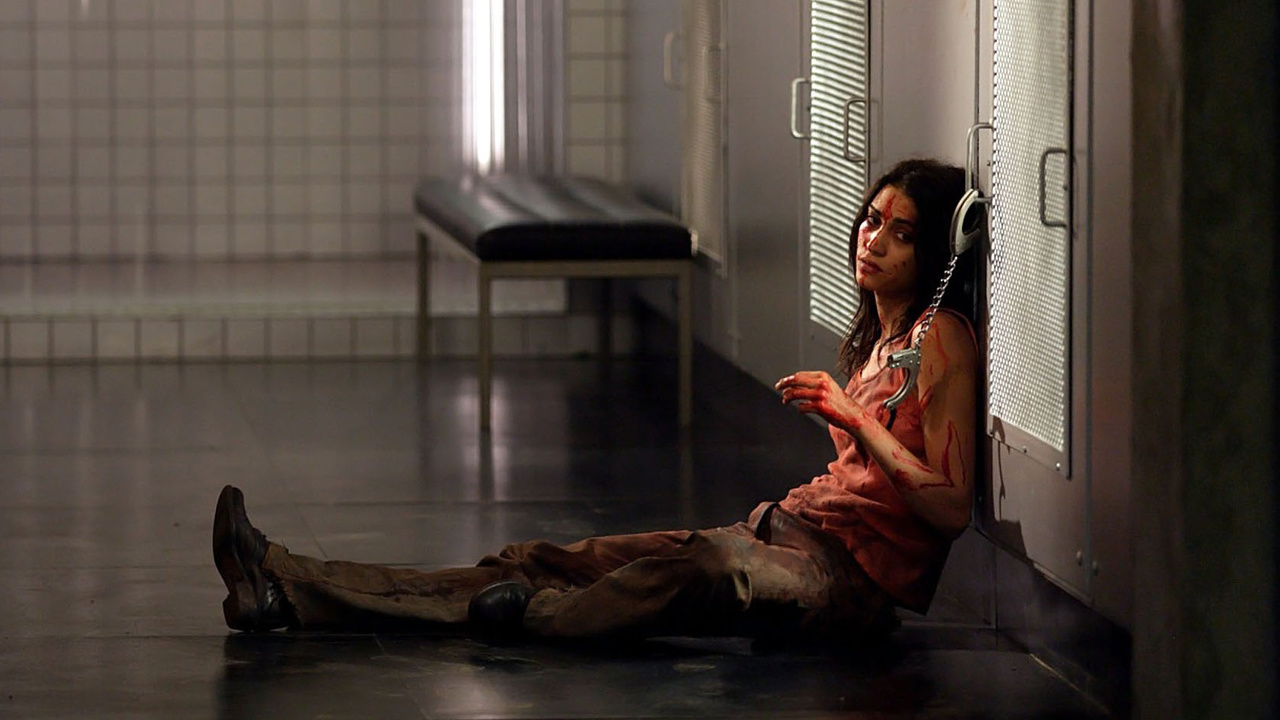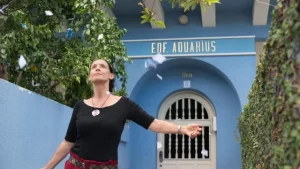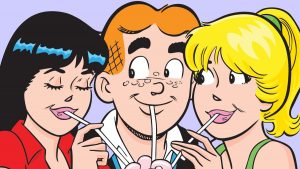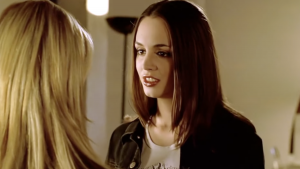
It is very, very rare that I feel genuinely horrified while watching a horror movie. I might feel my pulse race or I might actually flinch when there’s a jump scare, but I’m not compelled to feel real dread or terror. For better or worse, Pascal Laugier’s Martyrs (2008) has proven that a horror film can be horrifying, disgusting, repulsive, and absolutely brilliant at the same time. The only drawback is that the film is excruciatingly painful to watch. It is the price we, as viewers, must pay to see true art in the realm of extreme horror.
The story follows the tragic life of Lucie Jurin (Mylène Jampanoï), a young girl who, in 1971, escapes an abandoned building where she had been systematically tortured and abused for more than a year. After being placed in an orphanage where she struggles to socialize, Lucie is befriended by another young girl, Anna Assaoui (Morjana Alaoui). The two develop an inseparable bond, though Lucie struggles to shake off the demons of her past. She is tormented by a disfigured woman who appears and attacks her at random.
Fast forward 15 years and Lucie tracks down a married couple whom she believes to be responsible for her torture. She kills the parents and their two children with a shotgun. When Anna arrives at the large country house, she attempts to help Lucie cope with what has happened. Lucie believes that killing the perpetrators will rid her of the nightmarish creature that torments her, but she continues to be followed and attacked by the woman nonetheless.
While Lucie tries to rest and recover from her injuries, Anna begins to clean up the bodies, only to find that the mother has survived her gunshot wounds. Anna attempts to help her escape, but Lucie finds them and bashes the woman’s skull until she is long past dead. Lucie is devastated that Anna ostensibly doesn’t believe her, or that she thought the woman was worthy of saving. Soon after, Lucie is once again visited by the monstrous woman; we watch the scene unfold from Anna’s perspective this time, which shows that the woman is just a figment of Lucie’s tortured mind. In any case, the “monster” ultimately pushes Lucie to slit her wrists and kill herself.
Now left to grieve the death of her friend and clean up the scene of the crime on her own, Anna starts investigating the house, where she finds a secret passageway leading down to a high-security facility. Within the facility, she finds a woman bound in chains. The woman resembles the monster that constantly tormented Lucie. Realizing that Lucie had been telling the truth all along, Anna attempts to help the poor woman.

The chained woman is covered in scars and has lost the ability to speak. Her eyes are covered by a metal plate that has been drilled into her skull. Anna tries to soothe the woman by putting her in a warm bath and showing her compassion, but she tries to remove the metal casing from the woman’s eyes and finds that it has melded with the skin on her face. When Anna finally removes the contraption, the woman’s skin and scalp come with it. From there, the tortured woman runs away and finds a machete, which she uses to try to chop her own arm off. Anna does her best to calm the woman, who seems perpetually tortured by unseen forces. Before Anna can find a solution, a team of military-like personnel enters the home, shoots the woman dead, and takes Anna hostage in the underground facility.
It is here that the mystery of Lucie’s past comes into clearer focus. An unnamed woman (Catherine Bégin) enters and, through somewhat rushed exposition, explains the purpose of the facility to Anna. We discover that the woman is part of an organization working to find “martyrs,” or people who have undergone so much pain and suffering that they have achieved transcendence. The woman claims that young girls tend to make the best subjects, but thus far, all of the victims have either died or gone insane before actually reaching martyrdom. Now, Anna is their latest test subject.
The remainder of the film is primarily sequences of brutal violence committed against Anna on a routine basis. Eventually, the organization decides that she is ready to enter the final stage, which involves her being completely flayed alive. This leads us to the final sequences of the film, though the Martyrs ending leaves us with more questions than answers.
You might not like that I’ve essentially laid out the entire plot for you, but I think it is necessary to know exactly what you’re getting into before watching a film like Martyrs (2008). Not to be confused with the American Martyrs remake from 2015, which dials back the violence and torture significantly, the original French version is by no means an easy viewing experience.
People often criticize the horror genre for fetishizing violence against women. In many cases, this critique is fully and completely warranted. Though various critics vilified director Pascal Laugier for making such a horrible showcase of violence against women, I think films like Martyrs serve a very real and important purpose. The sequence of images in the film goes far beyond mere horror tropes and violent acts; they are grotesque, horrifying, and terribly realistic. Even the most ardent misogynist would walk out of the theater feeling sick to their stomach after watching the suffering that (mostly) men inflicted on these women.

Many viewers may not like the idea of watching a film that is purposefully grotesque and difficult to watch — and that is completely understandable. However, if you think you have the stomach for it, Martyrs is a beautifully horrific masterpiece. It is the kind of horror film that stays with you for months or even years after you’ve seen it. In short, you will not forget it anytime soon.
In my opinion, this is not just a side effect of its extreme violence; it is evidence of a horror film that truly fulfills its purpose. Why do so many people remember The Exorcist (1973)? Because it was (and is) a truly terrifying film. It pushes the limits of what is acceptable to watch while combining these boundary-pushing elements with frightening and unforgettable imagery. The same applies to Martyrs, though the latter goes significantly farther in the direction of unfiltered violence.
Moving away from the more visceral aspects of the film for a moment, Martyrs (2008) functions in an incredibly interesting philosophical space. The “organization” responsible for all of the suffering uses people (primarily women) as sacrifices in pursuit of discovering what comes after. They simply want an answer to the age-old question: what happens after death? Therefore, the martyrs they hope to create are humans who have transcended their physical form and are able to, albeit somewhat briefly, exist somewhere between life and death. Unfortunately for their victims, the organization is willing to commit all sorts of evil to find an answer.
In closing, I would be remiss to ignore the filmmaking elements that make Martyrs so much more than just a parade of violent images. The editing and staging are just as brutal as the imagery, forcing us to see everything with horrific clarity. At the same time, the Martyrs cast does an impeccable job making every part of it feel so real. In the end, this is what makes Martyrs (2008) such a successful horror film. It is an insanely brutal story that is made to be completely believable.
If you just want to see blood and gore and excessive violence, you can always turn to films like Hellraiser or Saw or Hostel. But, for all of their disgusting imagery, none of these films make you feel as if you could be watching real events play out on screen. With Martyrs, the filmmakers accomplish this amazing feat. As a film that came out at the tail end of the New French Extremity, Martyrs takes the hyper-realism of early 21st Century French horror and combines it with one of the most difficult and brilliant stories built on trauma, guilt, pain, suffering, and discovery. Just remember, there are some things that you can’t unsee — and this film is one of them. And if you want to see an amateurish and toned-down version, you can always watch the Martyrs 2015 remake.
Martyrs (2008) Movie Rating: ★★★★½ out of 5
If you’d like to watch Martyrs (2008), it is currently available to rent, purchase, or stream in certain locations via Amazon. You can also find it for purchase (with English subtitles) on Youtube. For more film reviews like this one, be sure to check out the Philosophy in Film homepage!
The post Martyrs (2008), A Terrifying, Difficult, and Painful French Masterpiece appeared first on Philosophy in Film.





